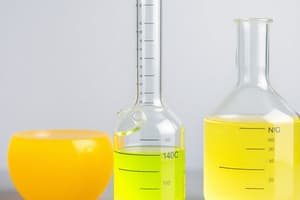Podcast
Questions and Answers
Why did Arrhenius' theory fail to explain the behavior of some compounds like NH3?
Why did Arrhenius' theory fail to explain the behavior of some compounds like NH3?
- It failed to address the behavior of noble gases
- It focused only on aqueous systems
- It did not consider the reaction with hydrogen chloride
- It could not explain the behavior of compounds without hydroxyl ions (correct)
According to Arrhenius, how is an acid defined?
According to Arrhenius, how is an acid defined?
- A substance that releases oxygen gas
- A substance that liberates hydrogen ions, H+ (correct)
- A substance that supplies hydroxyl ions, OH−
- A substance that reacts with water molecules
Why is the Brönsted–Lowry theory considered more useful than the Arrhenius theory?
Why is the Brönsted–Lowry theory considered more useful than the Arrhenius theory?
- It can represent ionization in both aqueous and non-aqueous systems (correct)
- It uses a different set of chemical symbols
- It focuses only on strong acids and bases
- It was proposed earlier than the Arrhenius theory
According to Arrhenius, how is a base defined?
According to Arrhenius, how is a base defined?
Why did Arrhenius' theory fail to explain the behavior of some compounds like NH3?
Why did Arrhenius' theory fail to explain the behavior of some compounds like NH3?
What makes the Brönsted–Lowry theory more useful than the Arrhenius theory?
What makes the Brönsted–Lowry theory more useful than the Arrhenius theory?
Flashcards are hidden until you start studying




